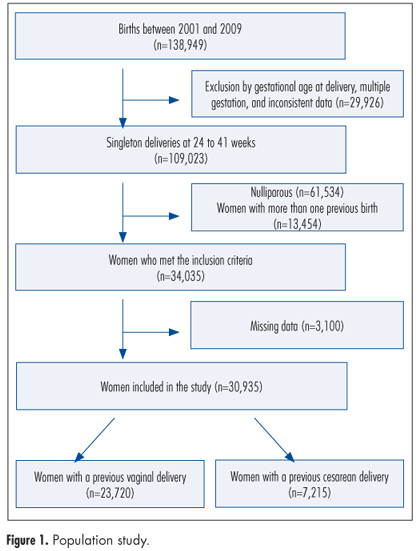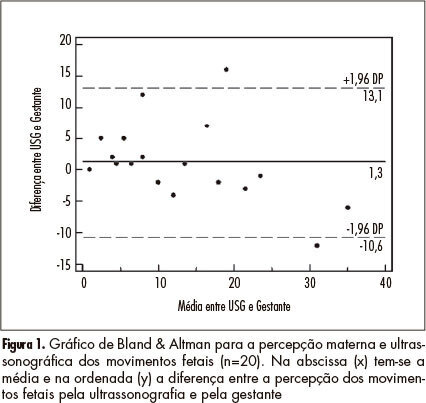Summary
Revista Brasileira de Ginecologia e Obstetrícia. 2014;36(1):29-34
DOI 10.1590/S0100-72032014000100007
To evaluate the maternal risk factors that require newborn assistance in neonatal Intensive Care Units (ICU).
A prospective observational case-control study was conducted on 222 pregnant women (1:1 case-control ratio) attended at a public maternity. The following variables were analyzed in the puerperae: age at menarche, age at first sexual intercourse, history of chronic diseases, habits, prenatal care, obstetric history, clinical complications during pregnancy and childbirth, and sociodemographic variables. The variables of the newborns were: Apgar scores, gestational age, birth weight, presence or absence of malformation, need for resuscitation, and complications during the first 24 hours. Proportions were compared using the Fisher exact test or the Person γ2 test. Multivariable models were developed by logistic regression analysis using adjusted Odds Ratio with a 95% confidence interval (CI).
Regarding reproductive history, ≥3 pregnancies and 2 or 3 previous cesareans were sytatistically significant (p=0.0 and 0.0, respectively). Among the complications that required assistance in the neonatal ICU, prematurity was responsible for 61 cases (55.5%), followed by risk of intrapartum infection in 46 cases (41.8%). Regarding the maternal history, the presence of hypertensive disease showed statistical significance (p=0.0). Premature rupture of membranes was strongly associated with the need for the neonatal ICU (Odds Ratio - OR=6.1, 95%CI 2.6-14.4).
Premature rupture of membranes and hypertensive disease should receive special attention in prenatal care due to their strong association with newborns requiring assistance in the neonatal ICU.
Summary
Revista Brasileira de Ginecologia e Obstetrícia. 2013;35(8):373-378
DOI 10.1590/S0100-72032013000800007
PURPOSE: To compare by transvaginal ultrasound the position of the intrauterine device (IUD) inside the uterine cavity, depending on the time of insertion, postpartum and post-abortion, and during the menstrual cycle. METHODS: Epidemiologic, observational and cross-sectional study carried out between February and July, 2013. A total of 290 women were included, 205 of them with insertion during the menstrual cycle and 85 during the postpartum and post-abortion periods. The independent variables were: age, parity, time of use, insertion time, number of returns to family planning, satisfaction with the method, wish to continue using the device, symptoms and complications. The dependent variable was the adequate position of the IUD inside the uterine cavity. The χ² test with Pearson's correction and the Fisher exact test were used for statistical analysis, with the level of significance set at 5%. RESULTS: The average age was 29.4 years and the average time of IUD use was 2.7 years; 39.3% of the women had symptoms associated with the method, the most frequent being menorrhagia (44.7%). The degree of satisfaction was 85% and 61.4% of the women returned two or more times for consultation about family planning. Age, parity and the position of the uterus in the pelvic cavity was not associated with a poor position of the IUD inside the uterine cavity (p>0.05). Insertion during the menstrual cycle was significantly more associated with a correct position of the IUD than postpartum and post-abortion insertion (p<0.028). CONCLUSION: Postpartum and post-abortion insertion showed worse results regarding the adequacy of IUD position, a fact that was not observed regarding age, parity or position of the uterus in the pelvic cavity.
Summary
Revista Brasileira de Ginecologia e Obstetrícia. 2013;35(7):331-335
DOI 10.1590/S0100-72032013000700008
The sclerosing stromal tumor of the ovary is an extremely rare benign tumor more common in young women and without specific symptoms in most cases. Less than 150 cases have been described, of which 8 were diagnosed during pregnancy. In this report, we describe the association between sclerosing stromal tumor of the ovary, Meigs' syndrome and elevated levels of CA-125 in term pregnancy.

Summary
Revista Brasileira de Ginecologia e Obstetrícia. 2013;35(5):205-209
DOI 10.1590/S0100-72032013000500003
PURPOSE: To investigate the impact of pregnancy on female sexual function. METHODS: An analytical, cross-sectional study was conducted on 181 non-pregnant and 177 pregnant women aged 18 to 45 years. The study included premenopausal, sexually active women with a steady partner and excluded those taking antidepressants or with a diagnosis of depression. Eleven of these women (6.2%) were in the first trimester, 50 (28.2%), in the second trimester and 116 (65.5%), in the third trimester of pregnancy. The evaluation consisted of an interview in which the Female Sexual Function Index (FSFI) was applied. The data were analyzed using the Statistical Package for the Social Sciences (SPSS) software, version 16.0. The nonparametric Mann-Whitney test was used to compare the mean FSFI values of pregnant and non-pregnant women. RESULTS: Sexual dysfunction was 40.4% among pregnant women and 23.3% among non-pregnant women, with a significant difference between the scores of the studied groups (p=0.01). The difference in the mean global FSFI values between the groups was also significant (p<0.0001). There were significant differences between pregnant and non-pregnant women regarding desire (p<0.0001), excitation (p=0.003), lubrication (p=0.02), orgasm (p=0.005) and satisfaction (p=0.03). The same was not observed regarding pain. CONCLUSION: We conclude that pregnancy negatively influences female sexual function, particularly the desire and excitement domains, revealing the importance of addressing the issue by professionals dealing with pregnant women.
Summary
Revista Brasileira de Ginecologia e Obstetrícia. 2013;35(4):148-152
DOI 10.1590/S0100-72032013000400003
PURPOSE: To examine obstetric outcomes in the second birth of women who had undergone a previous cesarean delivery. METHODS: This was a large hospital-based retrospective cohort study. We included pregnant women who had a previous delivery (vaginal or cesarean) attending their second birth from 2001 to 2009. Main inclusion criteria were singleton pregnancies and delivery between a gestation of 24 and 41 weeks. Two cohorts were selected, being women with a previous cesarean delivery (n=7,215) and those with a vaginal one (n=23,720). Both groups were compared and logistic regression was performed to adjust for confounding variables. The obstetric outcomes included uterine rupture, placenta previa, and placental-related complications such as placental abruption, preeclampsia, and spontaneous preterm delivery. RESULTS: Women with previous cesarean delivery were more likely to have adverse outcomes such as uterine rupture (OR=12.4, 95%CI 6.8-22.3), placental abruption (OR=1.4, 95%CI 1.1-2.1), preeclampsia (OR=1.4, 95%CI 1.2-1.6), and spontaneous preterm delivery (OR=1.4, 95%CI 1.1-1.7). CONCLUSIONS: Individuals with previous cesarean section have adverse obstetric outcomes in the subsequent pregnancy, including uterine rupture, and placental-related disorders such as preeclampsia, spontaneous preterm delivery, and placental abruption.

Summary
Revista Brasileira de Ginecologia e Obstetrícia. 2013;35(2):78-83
DOI 10.1590/S0100-72032013000200007
PURPOSE: To understand the reproductive and sexual life of women treated for breast cancer. METHODS: A total of 139 women with a diagnosis made at least 6 months ago were interviewed after being randomly selected in a rehabilitation service. The interviews were carried out between 2006 and 2010. The inclusion criteria were: to have used a rehabilitation service between 2006 and 2010, to be a Unified Health System user, to have been a patient at a regional hospital and to be resident in the area of DRS XIII-Ribeirão Preto, state of São Paulo. The interviewees were visited at home where a face to face questionnaire regarding sociodemographic features and questions about the disease and reproductive and sexual life was administered. For the last one, the Female Sexual Function Index instrument was used. Data were analyzed statistically by the χ² test, Fisher exact test, Student's t test, multivariate analysis by logistic regression, factorial analysis and the Cronbach's alpha. RESULTS: Most patients had between 2 to 3 children and 80% used some contraceptive. About half of them had had sexual intercourse in the last month, 45.3% had interrupted sexual intercourse during treatment and 25.9% did not. There were reports of decreasing sexual activity, although half of the interviewees had re-started sexual life during the first six months after treatment. About half presented sexual dissatisfaction. An active sexual life is associated with being younger than 40 years of age and to have a partner. No association was found between active sexual life and diagnosis and types of treatment. CONCLUSION: Sexual activity of women treated for breast cancer is not associated with the treatments, but with age and with the opportunity of having sex.
Summary
Revista Brasileira de Ginecologia e Obstetrícia. 2013;35(2):60-65
DOI 10.1590/S0100-72032013000200004
PURPOSE: To evaluate the effectiveness and the safety of orally administered misoprostol in comparison to intravenously infused oxytocin for labor induction in term pregnant women. METHODS: Between 2008 and 2010, a total of 285 term pregnant women whom were candidate for vaginal delivery were assessed for eligibility to enter the study. Twenty five patients were excluded for different reasons; and 260 included women were randomly assigned to one of the two groups according to the method of treatment, misoprostol or oxytocin. The misoprostol group received 25 µg every 2 hours for up to 24 hours for induction. The oxytocin group received an infusion of 10 IU which was gradually increased. The time from induction to delivery and induction to the beginning of the active phase and successful inductions within 12, 18, and 24 hours were recorded. The trial is registered at irct.ir, number IRCT2012061910068N1. RESULTS: Failure of induction, leading to caesarean section was around 38.3% in the oxytocin group and significantly higher than that of the misoprostol group (20.3%) (p<0.001). Despite the more prevalent failure in the oxytocin group, the mean time intervals from induction to active phase and labor of this group were both significantly less than the misoprostol group (10.1±6.1 and 13.2±7.7 versus 12.9±5.4 and 15.6±5.1 hours respectively, both p-values were <0.05). Maternal and fetal complications were comparable between groups except gastrointestinal symptoms which were encountered more frequently in the misoprostol (10.9 versus 3.9%, p=0.03). CONCLUSIONS: Misoprostol is a safe and effective drug with low complications for the induction of labor. Failure is seen less with misoprostol and caesarean sections are less frequently indicated as compared to oxytocin.
Summary
Revista Brasileira de Ginecologia e Obstetrícia. 2013;35(2):55-59
DOI 10.1590/S0100-72032013000200003
PURPOSE: To determine the agreement between maternal perception of fetal movements and the movements recorded simultaneously by ultrasound in low-risk pregnancies. METHODS: Twenty pregnant women were evaluated with the following inclusion criteria: single pregnancy, alive fetus, maternal age between 18 and 35 years; between 36 and 40 weeks gestation; normal fetal morphology at ultrasound, and absence of maternal comorbidities. The pregnant women were evaluated for 10 minutes, during which cardiotocography was used to record fetal movements triggered with the event marker, with the paper speed set at 3 cm/min. At the same time, fetal movements were observed by ultrasonography. RESULTS: The kappa index for interobserver agreement analysis was 0.62, showing good agreement (95%CI 0.45 - 0.79). The intraclass correlation coefficient was 0.82 (95%CI 0.61 - 0.92). Analysis by the Bland & Altman graph indicated good agreement. A linear regression analysis showed a significant correlation between maternal perception (x) and ultrasound (y) observation (r²=0.71, p<0.001; equation: y=5.31+0.66x). CONCLUSIONS: The agreement between ultrasound and maternal perception of fetal movement is good, allowing the use of fetal movement counting in the assessment of fetal wellbeing.
